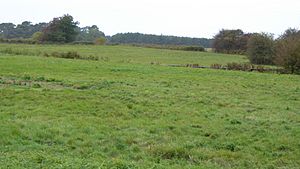Old Bodney Camp facts for kids
| Site of Special Scientific Interest | |
 |
|
| Area of Search | Norfolk |
|---|---|
| Interest | Biological |
| Area | 32.8 hectares (81 acres) |
| Notification | 1986 |
| Location map | Magic Map |
Old Bodney Camp is a special natural area in Norfolk, England. It's about 32.8 hectares (81 acres) (81 acres) big. This place is called a Site of Special Scientific Interest because it has unique plants and animals. It's also part of the larger Breckland Special Protection Area, which helps protect important wildlife.
Contents
What Makes Old Bodney Camp Special?
Old Bodney Camp is a "biological" Site of Special Scientific Interest (SSSI). This means it's protected because of its important plants, animals, or habitats. The government protects these areas to make sure rare wildlife and natural features are safe.
A Unique Habitat
This area is mostly a "heath" habitat. Heaths are open areas with low-growing plants like heather. Old Bodney Camp also has areas of grassland. You can find lots of lichen and moss growing here too. These different types of land create homes for many creatures.
The Role of Rabbits
Believe it or not, rabbits help keep this special place healthy! Their grazing (eating plants) stops bigger plants and trees from growing too much. This helps keep the heath and grassland open, which is perfect for the smaller plants and insects that live there.
Rare Moths of Breckland
Old Bodney Camp is home to two very rare types of moths. They are called Noctua orbona and Scopula rubiginata. These moths are "nationally rare," meaning there are very few of them left in the whole country.
Why Breckland is Important for Moths
These two moth species are almost only found in the Breckland region. Breckland has a unique dry, sandy soil and special plants that these moths need to survive. Protecting places like Old Bodney Camp helps make sure these rare moths have a home for the future.
Visiting Old Bodney Camp
Old Bodney Camp is private land. This means there is no public access for visitors. It's important to respect private property and help protect these special natural areas.

